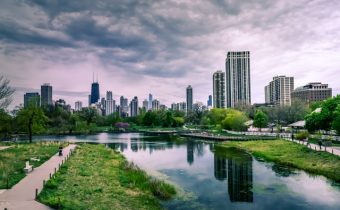
By Lana Hawkins
The UN warns that by 2050 about 67% of the world’s population will be living in cities, which brings new challenges to spatial, social, and environmental balance in urban areas. Optimization of resource use, increased safety, mobility, as well as reduced environmental footprint are to become the main concerns. Let’s check out some of the benefits of sustainable cities integrate smart tech and down-to-earth eco-friendly practices.
Reduced stress
People who live in urban areas are exposed to noise, traffic, and overcrowded public transport every day. To mitigate the impact of high population and traffic density, green city planners base sustainable city mobility on multimodal transport that encourages the population to use bikes, scooters, and electric cars. Urban nature islands such as parks and walkways, some of which can be incorporated into sustainable building design, provide calming and inspiring environments that encourage learning, as well as help children develop cognitive and behavioral connections and alertness.
Effective rainwater management
The traditional network of stormwater drains has proven ineffective when faced with increased precipitation patterns caused by global warming. In addition, huge amounts of concrete that covers the ground prevents rainwater from soaking in. As a result, upstream runoff causes landslides, weakening the ground and polluting rainwater with waste, which requires additional treatment downstream. To prevent this, sustainable city projects include more vegetation that is able to absorb large quantities of water, as well as using porous materials as a substitute for concrete.
Locally produced food
Transporting massive amounts of food to sustain the increasing urban population is a major cause of pollution and congestion. However, it’s difficult to reduce “food miles” and promote short circuit logistics if there are no gardens close to cities. The sustainable city infrastructure combines the advantages of green spaces and gardens of edibles. Collective kitchen gardens can be made at the foot of buildings, as well as on rooftops, so residents can benefit from seasonal vegetables as well as stress-reducing advantages of tending to plants.
Improved public safety
Since first gas lamps were introduced in the streets of London in 1807, the city authorities noticed that the crime rate plummeted. To reach public safety on a level that 19th-century lamp-lighters could only dream about, sustainable cities of tomorrow should have energy-efficient and high quality illumination of all public spaces. As part of the city IoT infrastructure, public lighting is being equipped with sensors, cameras, and wireless connectivity to analyze traffic information, as well as use the system of lamp posts as a grid to pinpoint the location of an incident for law enforcement and first responders.
Weakened impact of heat islands
In the last few decades, urban areas have become notorious for the so-called “heat island” effect. This thermal phenomenon creates a temperature surge in areas where lots of buildings, cars, lights, and asphalt are tightly packed, especially in the summer. One of the ways green city planners fight these heat waves is by breaking up the concrete core with belts of greenery, but there are also architectural solutions, such as roof tiles treated with heat-reflecting coatings, grass roofs, and green walls.
Decreased pollution
Our cities are dangerously suffocating in dust and carbon emissions that cause asthma, chronic coughs, and even cancers. A fully developed tree can retain up to 5.5 metric tons of carbon dioxide and 20kg of dust a year, so city planners are ready to include a greater percentage of green areas in cities of the future, including green roofs. Designed by Dutch artist and innovator Daan Roosegaarde, Beijing’s Smog Free Tower can clean 30,000 cubic meters of air every hour, using only 1,170 watts of energy. This 7-meter tall construction uses patented positive ionization to collect particles from the air, which are compressed and used to make Smog Free Rings which can be shared between people to raise air pollution awareness. Each ring contains particles from 1000m3 of purified air.
Social integration
Sustainable city planning can also be a source of jobs and social links by incorporating green community gardens in urban development schemes. These community green spaces can help socially alienated people re-establish contact with society through sharing common values for nature and outdoor activities. The French city of Lion, for example, took advantage of its astonishing geography and a variety of landscapes to promote outdoor activity by developing a series of programs that encourage both residents and visitors to exercise while learning about local heritage.
To meet with flourishing population demands, more and more cities are implementing some of these sustainability practices, each of which comes with a range of environmental and social benefits.
About the author: Lana is a stay-at-home mom, writer, and interior design enthusiast. She loves writing about sustainability, interior and landscape design. She enjoys playing in the kitchen and cooking for her friends and family, spending time in nature and learning about other cultures by travelling. She is a regular contributor to smoothdecorator.com







One comment